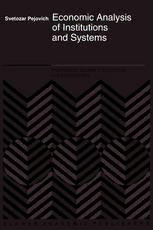
Economic Analysis of Institutions and Systems PDF
Preview Economic Analysis of Institutions and Systems
- ECONOMIC ANALYSIS OF INSTITUTIONS AND SYSTEMS International Studies in Economics and Econometrics VOLUME 33 The titles published in this series are listed at theeod oUhis volume. Economic Analysis of In stitutions and Systems Svetozar Pejovich Department of Economics, Texas A&M University, College Station, Texas KLUWER ACADEMIC PUBLISHERS DORDRECHT / BOSTON / LONDON Library of Congress Cataloging-in-Publication Data Pejovich. Svetozar. Economic analysis of institutions and systems I by Svetozar Pejovich. p. em. -- (International studies in economies and econometrics) Inc 1u des index. 1. Institutional economies. 2. Right of property. 3. Capital ism. 4. Social ism. I. Title. II. Series. HB99.5.P45 1995 330--dc20 94-40239 ISBN-13: 978-94-011-6485-6 e-ISBN-13: 978-94-011-6483-2 DOl: 10.1007/978-94-011-6483-2 Published by Kluwer Academic Publishers, P.O. Box 17, 3300 AA Dordrecht, The Netherlands. Kluwer Academic Publishers incorporates the publishing programmes of D. Reidel, Martinus Nijhoff, Dr W. Junk and MTP Press. Sold and distributed in the U.S.A. and Canada by Kluwer Academic Publishers, 101 Philip Drive, Norwell, MA 02061, U.S.A. In all other countries, sold and distributed by Kluwer Academic Publishers Group, P.O. Box 322, 3300 AH Dordrecht, The Netherlands. Printed on acid-free paper All Rights Reserved © 1995 Kluwer Academic Publishers Softcover reprint of the hardcover 1s t edition 1995 No part of the material protected by this copyright notice may be reproduced or utilized in any form or by any means, electronic or mechanical, including photocopying, recording or by any information storage and retrieval system, without written permission from the copyright owner. To my parents TABLE OF CONTENTS Preface ~ PART ONE: INSTITUTIONS AND PROPERTY 1 RIGHTS Chapter 1 The Nature of Economics 3 Chapter 2 The Rise of Capitalism and Socialism 7 Chapter 3 Institutions 29 Chapter 4 Law and Institutions 45 Chapter 5 Property Rights 65 PART TWO: PROPERTY RIGHTS, EXCHANGE, 77 AND PRODUCTION Chapter 6 The Coase Theorem and 79 Transaction Costs Chapter 7 Private Property Rights, 91 Exchange, and Production Chapter 8 Restrictions on Private Property 121 Rights, Exchange, and Production Chapter 9 Non-Private Property Rights, 137 Exchange, and Production Chapter 10 Institutions and Economic 155 Development vii Vlll PART THREE: THE FIRM 169 Chapter 11 The Firm and Contracts 171 Chapter 12 Capitalist Firms 189 Chapter 13 Socialist Firms 209 Index of Names 229 PREFACE The cold-war years (1945-1989) had two interrelated effects on teaching and research in comparative economic systems. First, Economic systems were perceived a contest between capitalism and socialism. Second, teaching and research during cold war years emphasized macroeconomics, economic growth and all sorts of statistical comparisons between the United States and Western Europe on the one hand, and (mostly) the Soviet Union and Yugoslavia on the other. In the late 1980s, East Europeans crossed the threshold of fear and forced their leaders to abandon both Marxism as a state religion and communism as a hazy vision of things to come. With the theory of history dead and buried, the cost of IIbuildingll socialism has increased relative to the present value of its expected future benefits. It is perhaps time to say: Economic Systems are Dead; Long Live Economic Systems. TIle purpose of this book is to redirect study of what we used to call comparative economic systems toward analysis of the history and development of institutions, and the effects of altemative institutional arrangements on economic behavior. To this end. the book internalizes into a theoretical framework: (i) the effects of alternative institutions on the costs of transactions and incentive structures, (ii) the effects of the costs of transactions and incentives on economic behavior, and (iii) the evidence for refutable implications of those effects. In the process, it provides the logical premises for various institutions from which refutable implications can be deduced. TIle book reveals my academic debt to a number of scholars, but especially to Armen Alchian. James Buchanan. Douglass North. and Richard Posner. I only hope that the book does not misrepresent (by much) their research. Over a long period of time, the Earhart Foundation has supported my research, and, most importantly, helped me to fonnulate ix x and stay on my own research-path. I couldn't have done it without the Foundation's support. I am also grateful to the Lynde and Harry Bradley Foundation for the financial support of my research on this book. An opportunity to spend several months at the International Centre for Economic Research in Turin, Italy gave me much needed time to plan this project. I want to thank Enrico Colombatto from the University of Turin for his support and encouragement in writing this book, Angelo Petroni from the University of Bologna for teaching me that economists could gain a lot from listening to philosophers of science, and to my dear friend loze l\iencinger from the University of Ljubljana for so many useful discussions during our long walks and even longer dinners in Turin. Special thanks to lohn Moore from George Mason University for inviting me to several conferences dealing with issues important to this book. Sally Antrobus provided valuable editorial assistance, Susan Dederich-Pejovich, my wife, provided "on-site" technical support for my computer, and my whole family let me work in peace, while giving loving support and understanding. Svetozar Pejovich College Station, Texas Summer 1994 PART ONE INSTITUTIONS AND PROPERTY RIGHTS
